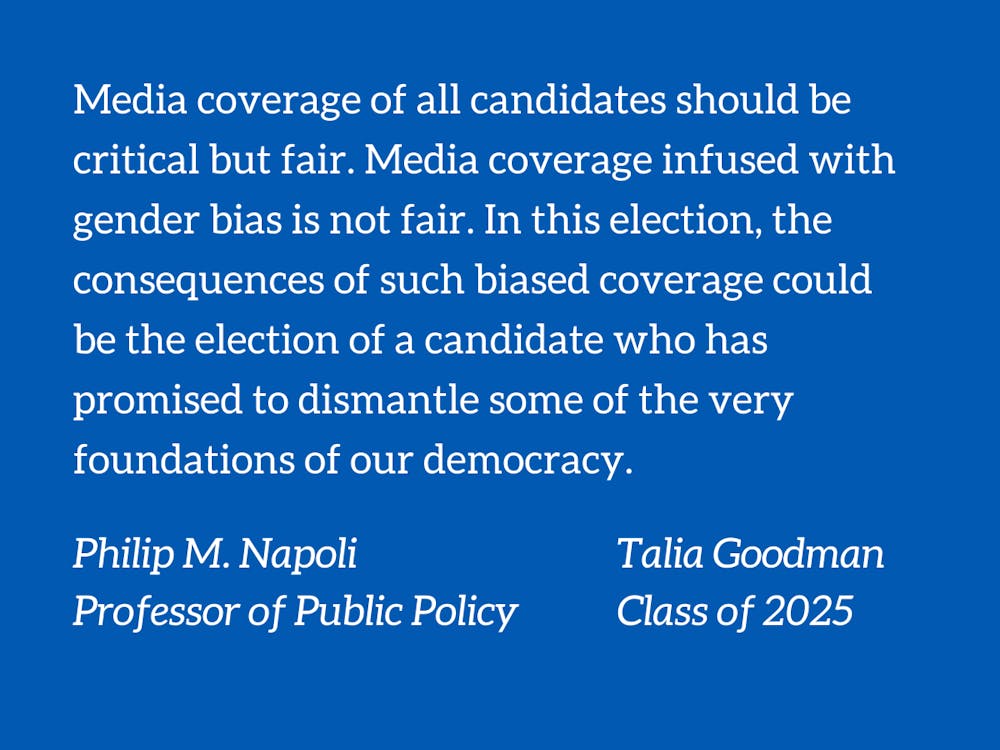This summer, the 2024 presidential election received a monumental shake-up when President Joe Biden withdrew his bid for re-election and threw his support behind Vice President Kamala Harris. Harris quickly amassed the delegate support necessary to secure the Democratic nomination.
Harris follows in the footsteps of Hillary Rodham Clinton as only the second female major party nominee for the presidency. If we learned one thing from the first go-round with candidate Clinton, it is that the news media have much to learn about how to fairly and properly cover a female presidential candidate.
There is a well-established pattern of American news media allowing gender bias to seep into their coverage of female politicians. We know, for instance, that journalists are more likely to ask female candidates about their domestic life (e.g., parenthood, marriage) than male candidates. We know that journalists are more likely to question the emotional state of female candidates and that they are more likely to focus on the appearance and voice of female candidates.
While these might seem like superficial differences in coverage, research has shown that they can negatively affect voters’ perceptions of the favorability of female candidates and their likelihood of voting for a female candidate.
Reflecting these patterns, when Hillary Clinton ran for president in 2016, research found that her physical appearance received significantly more news media attention than Trump’s and that her domestic life received considerably more attention than Trump’s. The news media also tended to focus more on the “likability” question in relation to Clinton than Trump. When Clinton addressed her gender, the media accused her of 'playing the victim' of sexism, whereas when Trump addressed his masculinity, he was portrayed as a powerful father figure naturally suited for an office.
Again, such differences in coverage can affect voter behavior. And in a political environment like ours, in which national elections are often decided by razor-thin margins, such differences can potentially affect an election outcome.
Also, campaign strategists are aware of these tendencies and can often work to exploit them. So it is no surprise that we’ve seen the Trump campaign and Trump supporters try to focus attention on subjects like Kamala Harris’ laugh, her prior romantic relationships, and the fact that she has no biological children. Campaign strategists know full well that such attacks cater to inherent biases in how the news media cover female candidates. And so, campaign attacks can help to generate biased news stories. As the economics of the news media have continued to deteriorate, news outlets may be even more susceptible to amplifying the campaign narratives put forth by political strategists, as well as those that go viral on social media.
Early indicators do raise concerns about the news media’s performance covering Kamala Harris so far. According to a recent analysis by media critic Margaret Sullivan, the news media seem to already be falling into the same “predictable blunders” when it comes to covering Kamala Harris.
Media coverage of all candidates should be critical but fair. Media coverage infused with gender bias is not fair. In this election, the consequences of such biased coverage could be the election of a candidate who has promised to dismantle some of the very foundations of our democracy. The burden of responsibility on the news media to get their coverage right has never been greater.
As Kamala Harris takes her next steps as the Democratic nominee, the news media's ability to provide unbiased coverage will be a litmus test for how far we've come — or how far we have yet to go — in achieving gender equality in politics.
However, it is not only incumbent on the news media to do a better job this time around in covering a female presidential candidate. It is also incumbent on all of us, as critical news consumers and citizens, to be cognizant of such biases when we see them and to not let them have undue influence over our candidate perceptions or our voting behaviors. The future of American democracy could literally hang in the balance.
Philip M. Napoli is the James R. Shepley Professor of Public Policy in the Sanford School of Public Policy, where he is also the Director of the DeWitt Wallace Center for Media & Democracy. Talia Goodman is a Trinity senior studying Public Policy. This piece is part of the “Virtues of Democracy” column, a series of op-eds by faculty and student contributors across Trinity College and the Sanford School of Public Policy. The column typically runs on Tuesdays or Thursdays.
Get The Chronicle straight to your inbox
Sign up for our weekly newsletter. Cancel at any time.

